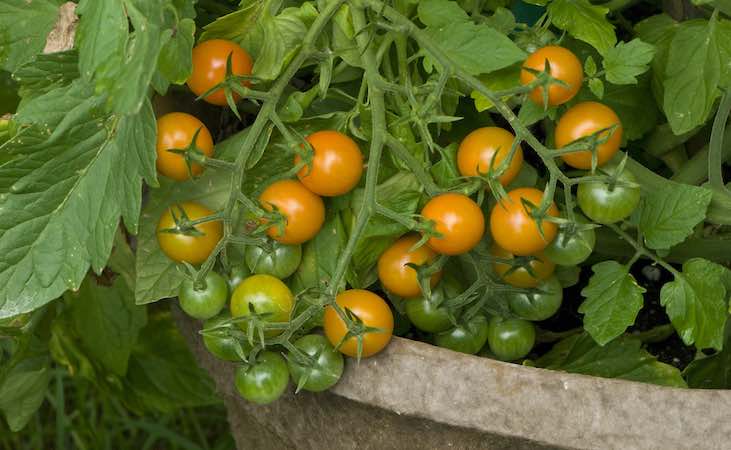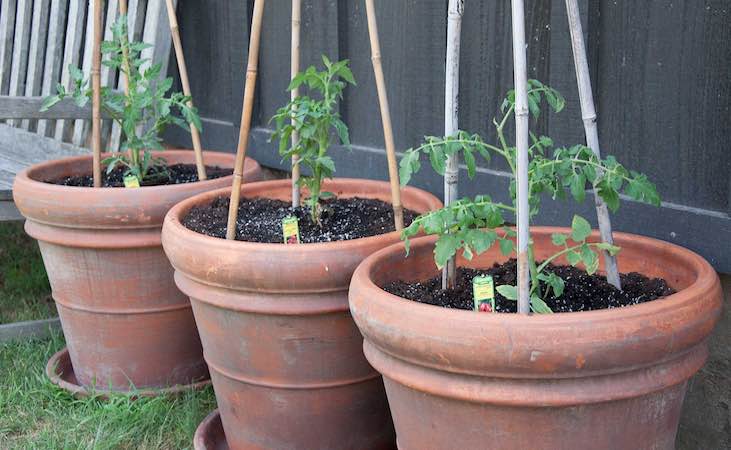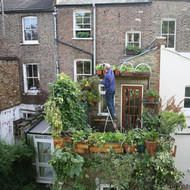Small Space Garden Tips

The number of people having a go at producing some of there own fresh produce is on the increase every year. The latest revolution is the small space urban gardener, who takes advantage of every square inch of space in their backyard or apartment balcony to produce their own fresh food.
The champion of UK urban growers has to be Mark Ridsdill Smith, of the excellent blog Vertical Veg. Mark set himself a challenge back in 2010 to see if could he grow as much produce on his balcony and windowsills as a London allotment.
According to the National Society of Leisure and Allotment Gardeners, a 330 square yard allotment produces £1,564 (€1,837) worth of crops a year. As Mark figured the average London allotment is half that size, he set his target at half that figure - at £782 (€918). After his 12 month trial, he estimated he'd grown almost £900.00 (€1,057) worth of produce. Not bad for the first year!

1.8m Vegtrug Vegetable Trough Planter
View ProductAnyway, I had a very interesting conversation with Mark about his specialised subject where he gave me an insight into some of the the issues a backyard grower might face.
It's been a while since I lived in the city myself, but I can remember growing chillies, tomatoes and salads on a tiny balcony. It's a great way to feel connected to the earth when all around is brick and concrete.

I may have dabbled in city growing, but Mark became an expert - so with a little help from him and plenty of waffle from me, here we go:
If you want to build a full blown vegetable garden or just start with some small pots of salad or herbs, what's the best way to get started? Here are some tips to get you going.
What are the best crops to grow in a small space?
Start small. You're probably thinking 'hey, I've only got a balcony, I
have to start small!' Fair enough, but what I mean is that plants take a little bit of looking after. You're much better off having a big success with a small number of pots or planters than a disaster when you've tried to do too much.

Fargro Herb Window Box (Stone)
View ProductI always advise beginners to start with herbs and salads, as they're fun and easy to grow. You can include other small container plants like spring onions, radishes or baby beets if you want to add more variety.
Once you find your feet and see how much time you can give to your new garden, you can move on to a wider range of crops. Hanging baskets of delicious homegrown tomatoes simply can't be compared to their bland shop-bought cousins, but will require a bit more care to get right.
Ideally you want crops which take up little space, can be picked over a long season and produce a large amount of crop. For summer growing I'd go for tomatoes, aubergines, courgettes, peppers (chili and sweet), dwarf peas and french beans. Of course you can also grow your staples like carrots, beetroot, spinach, chard, garlic and onions.

Vegtrug Tomato Greenhouse
View ProductI'm not sure it's worthwhile growing large crops like cabbage and cauliflower, because they take up so much room (a cabbage needs a metre square just for one head) and only give you one harvest. Conversely, plants like perpetual spinach will give you leaves all through the season from one or two plants - so are an excellent choice.
Crops and Light Requirements
You need to know how much sunlight your garden gets, as this will affect the crops you'll be able to grow. Fruit and vegetables need light to grow: ideally at least six hours a day, but some plants will need more light than others. There's no point in trying to grow tomatoes in a shaded back yard, but it may still be perfectly good for herbs and salads.

Mark has a really handy little table on his Vertical Veg 'The Art of Growing in Small Places' fact sheet:
LESS SUN (at least 3 – 4 hours a day):
- Most leafy crops: Lettuce, rocket & other salads
- Pak choi & stir fry greens
- Mint, parsley, coriander, chives
- Woodland fruits: Blueberries & blackcurrants
MORE SUN (5- 6 hours - nearly ½ day)
- Peas, beans and root crops: Runner & French beans, mangetout
- Potatoes
- Carrots
- Radish
LOTS OF SUN (6 hours - over ½ day)
- Fruiting crops: Tomatoes, courgettes or squash
- Chillies/peppers
- Strawberries
- Aubergines
N.B. you can download Mark's fact sheet FREE by joining his mailing list on the homepage of the Vertical Veg blog, just fill in the 'subscribe' box on the right hand side.

Carrot Patio Planter - 2 Pack
View Product
Container Growing in Small Spaces
Vegetables can be grown in a variety of containers, with some plants needing more room than others. Your range will be from about 15 cm deep for lettuce etc.. up to about 45 cm for squash, courgettes or fruit bushes.
Remember, the biggest issue you'll have with container growing is keeping everything watered. The bigger the pot you choose the less often you'll need to water.
Reservoir Planters
There are a number of planters on the market which contain a water reservoir in the bottom or sit in a reservoir tray. As I've already mentioned, watering will be one of the jobs you'll be doing a lot of with a planter garden - so it's a good idea to make it easy on yourselves.
Plants which are allowed to dry out will suffer stress, and may bolt (go to seed) in the case of many salads or become woody and tough in the case of roots like turnip, beets or carrots. What you're trying to achieve is nice and steady, even growth, which means you'll also want to keep your watering constant and even.

Vegepod Large Raised Bed Complete with Cover
View ProductReservoir planters are of differing design, but they all work in more or less the same way. The base of the planter will either contain a reservoir of water or sit in one, and is replenished every couple of days depending on the demands of the plant.
You can also mix a liquid feed in with the water (we love liquid seaweed products) to keep your nutrient levels high enough for heavy feeders like tomatoes or courgettes.

Liquid Seaweed Fertiliser - Better Plants
View ProductWhile reservoir planters are more expensive than normal planters, they're well worth it for some of the crops that need a little extra care.
How To Make Your Own Small Space Planter
Of course you can grow vegetables in almost anything, but make sure you avoid containers which have held toxic substances like paint or motor oil. Other than that you can let your imagination run wild.
For an old world natural look, fruit crates and old galvanised buckets look the part. If you're not so worried about the look, there are plenty of plastic and metal options like fish boxes, cooking oil drums and food tins.

Make sure you pierce drainage holes in the bottom of your tins: if the soil becomes waterlogged plants can 'suffocate', as there will be no air spaces in the soil for them to breath. We'd recommend placing a layer of gravel or broken earthenware in the bottom of the pot to improve drainage.
Soil or Compost for Containers and Planters
The most important part of growing anything is the soil or compost it grows in. This is where the plant gets its food, so you need to give it the best growing medium you can.
Soil will be more difficult to get, and if you want to grow on a roof garden you have to take into account the fact that it's much heavier than compost. It can also be trickier to get right for the beginner, so I'd recommend using a compost mix to begin with. I'll be going into soil mixes in more detail in a later article.
With regard to compost, we don't like using peat as it is a finite resource and prefer to use a peat-free alternative. Mark points out that New Horizon and Vital Earth came top in a recent Which? survey, so are a good place to start.
Remember that the nutrients in compost will only sustain the plant for 5-6 weeks, so you'll need to look at feeding after that. There are many alternatives to chemical fertilizers and we'd suggest going for the natural products over the chemical ones: some good options include seaweed liquid feeds or poultry manure pellets.

Seafeed Natural Seaweed Extract & Poultry Manure Fertilizer
View Product
Looking after a Small Space Garden
It's important to keep the compost in your containers moist. Unless you have a reservoir planter, you need to check every day by putting your hand down into the soil. It should be neither dry nor sopping wet, but of a moist crumbly consistency.
Watering in the morning is recommended, as evening watering means the plant can be sitting in cold, damp soil when night time temperatures fall. It's a bit like going to bed in wet pyjamas for plants!
There are a variety of pests which may or may not be a problem in your area, but well-fed healthy plants are much more able to resist attack than weaker plants. Keep your plants vigorous and strong and your pest patrol will be a whole lot easier.

Slugs will be the main offender, so check beneath your pots and planters as this is where they tend to hide.
That will do for now!
That should give you a general idea of how to garden in a limited space. Obviously there is much more detail to go into, which we'll be covering in later articles. Look out for tips, tricks and relevant products on the Quickcrop site, but also make sure you visit Mark at
Vertical Veg for expert advice. A big thanks to Mark for help and inspiration with this article.

Our aim is to ensure that the urban grower isn't forgotten about when it comes to stocking products here at Quickcrop. We're always on the look out for innovative solutions to space restrictions, whether it's products or garden design ideas.
If you've come across something that you find good or can't source elsewhere, please drop us a line and let us know. Or if you just want to show us your own ingenious small space 'hacks': send a photo in! We'll always be delighted to hear from you on 01788 298795 or mail us on info@quickcrop.co.uk





